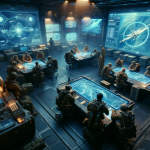As NASA gears up for its next moonwalk simulation, innovative strategies are being employed to ensure astronaut readiness for future lunar missions. This includes rigorous underwater training sessions aimed at replicating the low gravity environment of the moon. These simulations are critical in preparing astronauts for the complexities of lunar exploration, emphasizing the physical and psychological challenges posed by extraterrestrial conditions.
The evolution of space training methodologies has seen significant advancements since the early days of space exploration. Decades ago, the focus was primarily on basic survival in space, such as handling zero-gravity and operating spacecraft controls. Today, the training is much more scenario-based, with simulations covering everything from spacewalks to emergency situations. This shift reflects a deeper understanding of the varied challenges astronauts face during missions, driven by data from previous manned spaceflights and technological progress in simulation equipment.
Expanding Astronaut Training Techniques
NASA’s current training regimen includes more than just physical conditioning. Astronauts undergo extensive mental and technical training, where they face simulated challenges that they might encounter in space. This holistic approach ensures that they are not only physically prepared but also psychologically resilient and technically proficient for their tasks in space.
Global Collaboration in Space Exploration
International cooperation has also become a cornerstone of contemporary space missions. Countries around the world share knowledge, resources, and training techniques, fostering a collaborative international space community. This global network supports a variety of training programs, ranging from virtual reality sessions to joint underwater drills, enhancing the preparedness of international crews for joint missions.
Technological Advancements in Simulation
The technology used in astronaut training has evolved significantly, with high-fidelity virtual reality environments now playing a crucial role. These systems simulate the sensory and physical experiences of space travel, allowing astronauts to practice procedures and adapt to the emotional and physical demands of space missions.
In related reports, recent articles from Space.com titled “Virtual Reality Training for Astronauts” and from Scientific American titled “The Role of High-Tech Simulators in Astronaut Training” discuss the integration of advanced virtual and augmented reality technologies in astronaut training. These tools offer immersive simulations that are crucial for safe and successful space missions, highlighting the shift towards more technologically advanced preparation methods.
Useful Information
- Underwater simulations mimic lunar gravity, enhancing physical preparedness.
- International collaborations enrich training programs, widening skillsets.
- Advancements in VR technology contribute to realistic, effective training scenarios.
The future of astronaut training is likely to see even greater integration of technology, with artificial intelligence and machine learning providing adaptive learning environments. These tools will tailor training programs to individual astronaut needs, enhancing effectiveness and efficiency. As we move forward, the lessons learned from both historical and current training practices will guide the development of even more sophisticated preparation methods for astronauts, ensuring they are equipped to meet the challenges of next-generation space exploration.










